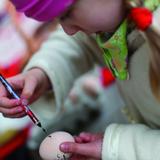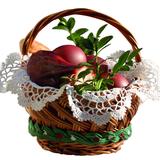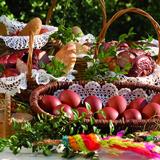Easter, the celebration of the resurrection of Jesus Christ, is the oldest and most important Christian festival. The way people celebrate Easter today owes a lot to the dozens of customs, traditions and rituals, some of which have their origins in pre-Christian beliefs. As Easter always falls on the first Sunday after the first spring full moon, many of its customs and rituals are connected with the passage from winter to spring.
 |
|
Palm Sunday falls on the week preceding Easter and commemorates Christ’s triumphant entry into Jerusalem. On that day, believers go to church carrying palms and bouquets of catkins, which are not only a reminder of the events described in the Gospel, but also an expression of the old folktales about the spring rebirth and renewal. For that reason, Palm Sunday also used to be referred to as Flower Sunday or Willow Sunday. On that day, boys with their faces blackened with soot (called “Pucheroki”) wearing their sheepskin coat inside out and conical hats decorated with colourful tissue, walk around in the morning down the streets of certain villages near Kraków (such as Zielonki, Bibice and Tomaszowice). The boys sing songs, wish others a happy Easter and are given pocket money or Easter delicacies in return. This custom dates back to the old tradition of Cracovian students who used to go around the townsmen’s flats. |
 |
|
The Holy Week begins after Palm Sunday and represents the time of awaiting Easter. Each day has its own particular religious significance and symbolism, which is why a lot of believers visit the church on each of those days. The Sanctuary of the Tomb of Jesus in Miechów is famous for its exceptionally ceremonious celebration of the Holy Week. On Palm Sunday, a procession with Christ riding a donkey is performed; on Tuesday there is a special procession of the Stations of the Cross around the town centre; the Good Friday procession marches along the cloisters of the monastery of the order of the Holy Sepulchre. |
 |
|
The Passion plays in the sanctuary in Kalwaria Zebrzydowska attract great numbers of pilgrims and tourists. The celebration begins with a staging of Christ’s triumphant entry into Jerusalem on Palm Sunday. On the evening of Holy Wednesday, one can watch the dramatic version of the pilgrims’ entry into the temple, Judas’ betrayal and the conference of the Sanhederin. Among the events commemorated on Maundy Thursday are: the ritual of washing the disciples’ feet, a procession to Gethsemane, the capture of Christ by the guards and the disciples’ escape to the palace of Caiaphas. The Biblical story continues on Good Friday, when the ongoing performance comes to an end with Christ being sentenced to crucifixion. What follows are the traditional Stations of the Cross. Less spectacular, but also worth mentioning are the Passion plays staged in the Bernardine monastery in Alwernia. |
 |
|
Easter eggs are traditionally prepared before Easter. The egg shells are first dyed using natural methods and then decorated in a variety of designs. There are workshops organised for those who wish to learn about some of the traditional techniques of decorating. Such classes can be attended, among other places, in Stryszawa (www.stryszawa.pl). |
 |
|
Holy Saturday, the last day of the Lent and the eve of Easter Sunday, is the time of joyful anticipation, when believers go to church to attend the ritual of the blessing of the foods (called święconka) prepared for the festive Easter meal, which they carry in special little wicker baskets. Among the necessary components of every Easter basket are Easter eggs (a symbol of new life) and a lamb made of sugar or dough, which symbolises the martyred Christ. Most people also add a slice of all kinds of specially prepared ham, a pinch of salt and a slice of bread. |
 |
|
Easter Sunday begins with a festive breakfast, during which all the delicacies from the blessed basket are served. Consuming the blessed foods is a reference to the new life granted by the resurrected Christ. Among the traditional specialties served during dinner are the whey-based rye soup (żurek), horseradish soup, cream-stained beetroot soup based on smoked bacon stock and served with white sausage. |
 |
|
Wet Monday (also known as Dyngus Day) is celebrated on the day following Easter Sunday, when girls were traditionally in danger of being sprinkled with water by the lurking boys. This tradition dates back to the pagan rituals connected with the symbolic spring act of cleansing of dirt and disease. Another Easter Monday tradition is Siuda Baba, a man dressed as a woman – with a potato-rosary in his hands and his face blackened with soot – who roams the environs of Wieliczka. He walks around churches accompanied by a soot-black gypsy with a whip. This tradition has its roots in the legend about the pagan temple of the goddess Leda in Lednica Górna near Wieliczka. The holy fire burning in the temple was sustained by a priestess performing her duties for the whole year. After one year elapsed, she went from house to house, her face black with soot, looking for a virgin who could replace her. Nowadays, Siuda Baba also looks for girls, who then have to buy themselves out with a coin and a kiss, which involves being smeared with soot… |
